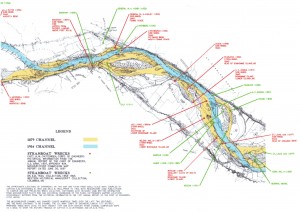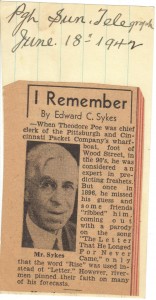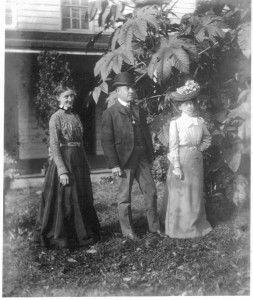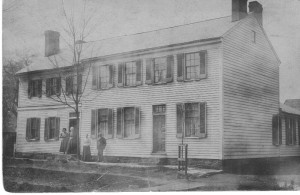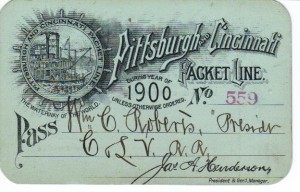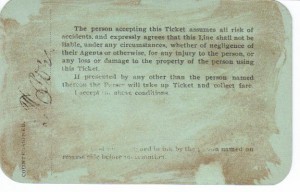Ms Barbara Macleish has introduced me to the reference “Chronicling America”.
About Chronicling America
Chronicling America is a Website providing access to information about historic newspapers and select digitized newspaper pages, and is produced by the National Digital Newspaper Program (NDNP). NDNP, a partnership between the National Endowment for the Humanities (NEH) and the Library of Congress (LC), is a long-term effort to develop an Internet-based, searchable database of U.S. newspapers with descriptive information and select digitization of historic pages. Supported by NEH, this rich digital resource will be developed and permanently maintained at the Library of Congress. An NEH award program will fund the contribution of content from, eventually, all U.S. states and territories.
So far 737 newspapers from 1836 to 1922 have been digitized. Unfortunately, western PA is not well represented. Fortunately OH, MO, and MT along the inland rivers are well represented during the steamboat era. No doubt I will be spending much time searching these references.
A good example of the findings from “Chronicling America” is the little known str Glaucus. The str Glaucus information provided by the original Certificate of Enrollment appears below followed by Capt Way’s entry in his Packet Directory. :
Str Glaucus
| Owners and Partners |
Share |
Vol: |
6633 |
| T Harvey Miller |
|
Enroll No : |
89 |
| Thom S Clarke |
|
Cert Date: |
6 Jul 1849 |
| Wm Thaw |
|
Cert Type:: |
Enrollment |
| Geo Black |
|
Build Locn: |
W Elizabeth, PA |
| Robert S Hays |
|
Build Date: |
1849 |
| Wm Bingham |
|
Master |
GW Ebbert |
| Wilson Miller |
|
|
|
| GW Ebbert |
|
|
|
Glaucus. The sidewheel wooden hull packet named the Glaucus was built in West Elizabeth, PA in 1849 for the St Louis to Keokuk Packet Line. Its capacity was 154 tons. George Washington Ebert was partner and its master. The Glaucus met a fiery end on 30 Mar 1852 in Montrose, IA. [1]
In addition to this original source info and Capt Way’s history, Ms Macleish has directed me to newspaper articles found in Chronicling America, as well as other more direct routes.
Gallipolis Journal 7 Aug 1851
By the tremendous hail storm
Saturday night, the steamer Glaucus
had her chimneys blown over, and
cabins badly shattered.
Hannibal Journal 25 Mar 1852 (Fri)
You may have heard of the loss of
the steamer Glaucus – if not, I will
tell you that she was burned at
Montrose on Friday last, while lying
there ice-bound. She belonged to the
Keokuk Packet Company, and was
insured for $5,000.
Democratic Banner (Davenport, Iowa)
1852 March 26
BURNING OF THE GLAUCUS.—On Saturday last, the Steamer Glaucus, on her upward trip from Keokuk, while lying ice-bound at Montrose, was entirely destroyed by fire. The fire originated in the steerage, and spread so rapidly as to prevent the recovery of anything, excepting the books and papers of the boat—even the passengers’ baggage was all destroyed. The Glaucus, we understand, was not intended to be run as one of the regular mail boats, between this point and Keokuk, but was to have been kept as a reserve, to run in case of need.
Day in history for March 28, 2002 – Quad-Cities Online
150 years ago: Passengers from the Lamartine, just arrived, informed us that the packet Glaucus burned about 11 a.m. yesterday while it was lying ice- bound at Montrose, Iowa. Not even the baggage of the passengers was saved
Notice the differences in the date the str Glaucus burned. The Hannibal Journal indicated 18 Mar, the Democratic Banner – 20 Mar, the Quad Cities Online – 27 Mar, and Capt Way – 30 Mar. Capt Way is my go to guy. If he writes something, then it is true, even if it was not.
This confusion of time, and sometimes identity in other cases, makes an accurate presentation of history difficult. Early American history is a story. How much is fact and how much is legend does not really matter, for it did certainly happen.
References.
[1] Frederick Way, Jr.,Way’s Packet Directory, 1848-1994, (Ohio University Press, Athens 1994), p. 188.
Copyright © 2012 Francis W Nash
All Rights Reserved
